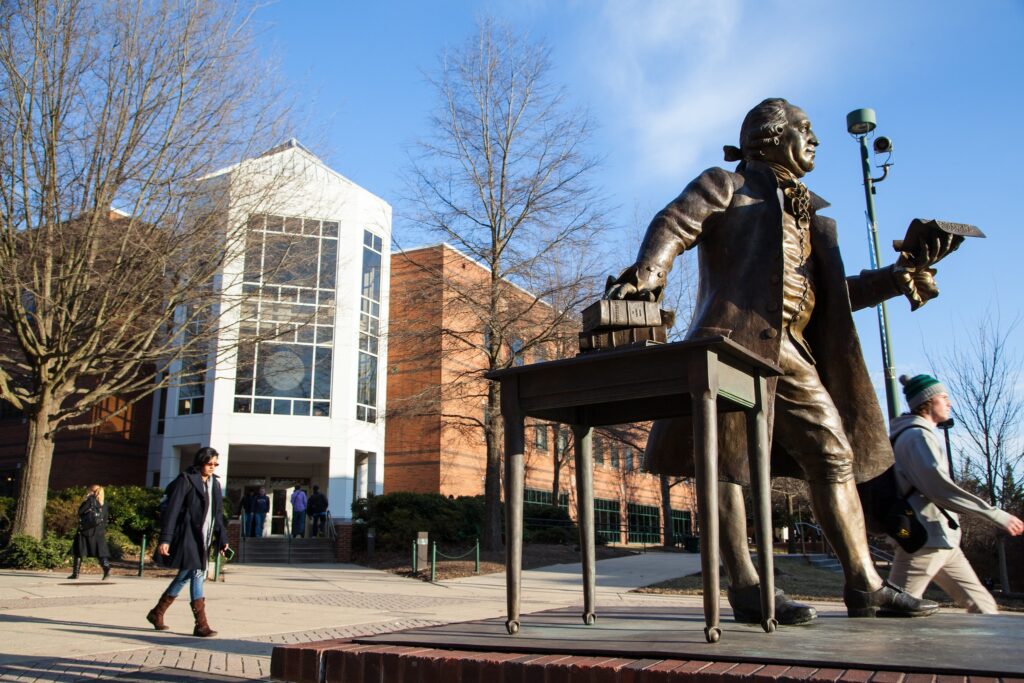Adrianne is a college admissions consultant and TV/film director, producer, writer, and actress currently based in LA. She uses her experience in multiple disciplines to help students achieve their personal and academic goals.
In the past few years, more schools have been utilizing “direct admissions,” or the expedited process of accepting students without having them submit a full application, to find their freshman class and boost college enrollment.

George Mason University — One of the schools participating in direct admissions
The college admissions process has become notoriously difficult in recent years — between submitting grades, extracurricular lists, letters of recommendation, essays, supplemental materials, and paying application fees, many students and families are finding the entire process overwhelming, which is discouraging for students who are already intimidated by the prospect of going to college.
However, a few schools have opted into a much quicker, cheaper alternative to the traditional application process: direct admissions programs. A direct admission program makes the process simpler and faster for both students and admissions officers by eliminating some of the most time-consuming components of the college application and waiving application fees.
When describing the process, Forbes likened it to being pre-approved for a loan or mortgage: “A student first creates and posts a profile, including information like grades, test scores, location, interests, and other college-relevant information. Participating colleges then evaluate those individual profiles and extend admission offers without requiring students to go through the hassle of obtaining letters of recommendation, writing an essay, and filling out application forms.” Applications are available through some state-run programs and private companies, such as the College Board’s Common App, Niche, and Concourse.
You may be wondering what the pros and cons to consider when deciding whether or not it might be a good option for you or your student — we’re here to break it all down.

The University of Idaho
Table of Contents
The Direct Admission Programs Available in the U.S.
The first direct admission program in the U.S. began in Idaho in 2015 as a way to increase access to higher education for Idahoan residents. This allowed all students who graduated from a public high school to receive an offer of admission to a set of public colleges and universities based on their GPAs, standardized test scores, and more statistics.
Since then, many states have followed suit. According to the Education Commission of the States, a nonpartisan organization that studies and reports on state education policy, there are at least 12 states that currently guarantee admission to their state and/or public universities and community colleges for certain eligible high school students.
Colorado, Illinois, and Texas have guaranteed admissions policies established in statute. Nine states have programs or initiatives established by their state Departments of Education or Board of Regents, such as Idaho. In addition to this, California has an admissions policy that prioritizes admission to eligible students, but admission is still subject to availability and university enrollment limits.
For the schools that guarantee admission as a matter of statute, they are typically required to automatically admit high school graduates who graduated in the top 10% of their class, as is the case in Texas. However, for the University of Texas at Austin, a relatively well-known college nationwide, the admissions threshold is just 6%, and state law requires 90% of students to be Texas residents, 75% of whom gain automatic admission. This explains why admission for out-of-state students is such a competitive process, and the academic requirements for automatic admission for in-state students are getting increasingly higher.
As mentioned above, there are many private companies that offer direct admission applications as well. In 2019, the College Board launched a direct admissions pilot program as part of the Common App.
Students applying to any school via Common App who meet GPA requirements could receive a non-binding direct admissions offer from participating schools. They still have to apply with their Common App, including a personal statement, extracurricular list, and so on, but this usually allows them to waive fees and skip additional essays, making the application process much simpler. There is a small list of schools, including community colleges and private schools, that students may hear from via the Common App’s programs.
Some smaller companies that do this include Concourse, an online platform that facilitates the submission of student profiles to universities and colleges that offer direct admission. Universities are then presented with anonymized versions of qualified students’ profiles, and from there, they decide whether to make proactive offers of admission and financial aid. This is also a great way for students to procure scholarships without spending countless hours researching potential opportunities. Niche also offers a similar program, providing students with college opportunities that they might not have otherwise considered.

The University of Texas at Austin
The Pros and Cons of Direct Admission
While using a direct college admission program may be an ideal option for some students and can increase the accessibility of higher education, it does have some drawbacks. Let’s break down the pros and cons.
The Pros
- Hassle-free, less expensive admission to college. As discussed at length above, direct admission can make the complex college admissions process considerably less daunting, time-consuming, and expensive. Hopefully, this could give many high school seniors the chance for a considerably less stressful school year!
- Expanding your potential college search. Direct admission may help you consider schools that weren’t previously on your radar and could be a better fit given your financial resources and academic goals.
- Increased awareness of financial aid and scholarships. You may not know which grants, scholarships, or other financial awards your standardized testing scores and personal achievements qualify you for — direct admissions programs make that process much simpler too.
- Colleges can more easily find the kind of students they want to attract and increase diversity on campus. On the college’s side of things, direct admission helps them identify and communicate with the students they want most, potentially leading to a more robust, diverse incoming freshman class.
- For instance, in 2021-2022, the Common App’s program reached 18,000 students with over 800 students accepting the offer, a large majority of whom were Black or African American, Latinx, and first-generation students.
The Cons
- Only a small number of schools use direct admission. Many prestigious universities and colleges don’t use direct admission, so the majority of schools that do are state, public, and community colleges that may be less well-known. Still, that doesn’t mean these schools don’t offer a great education and resources.
- Could prevent some students from finding a great college fit. An early college admissions offer could signal to students that they don’t need to look any further and can slack off for the rest of the year. It’s still worthwhile to consider all of your options and just consider a direct admissions offer as a potential choice.
- Boosts application numbers but not necessarily enrollment. A recent study found that “students offered direct admission to college were 12 percent more likely to apply to a postsecondary institution but no more likely than those who applied through traditional channels to enroll.”
In conclusion, direct admission is a new way to get into college that can be beneficial for some students. While it can make the college admissions process easier and cheaper, it does have some drawbacks. It may be worth considering all of your options before accepting a direct admission offer, as it may not be the best fit for everyone.

Want to stay up to date on the latest news in college admissions, or need help with your college applications? You can subscribe to our newsletter or schedule a free consultation with one of our admissions consultants.



